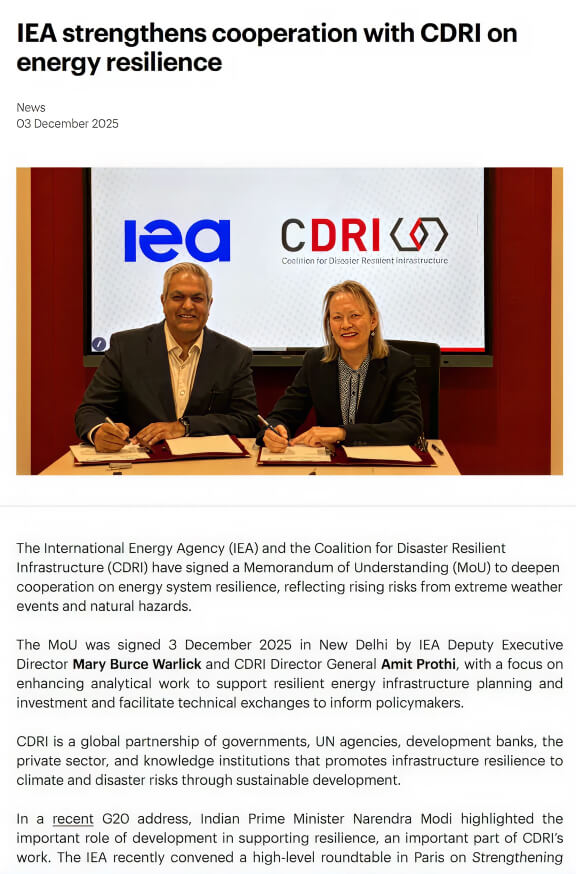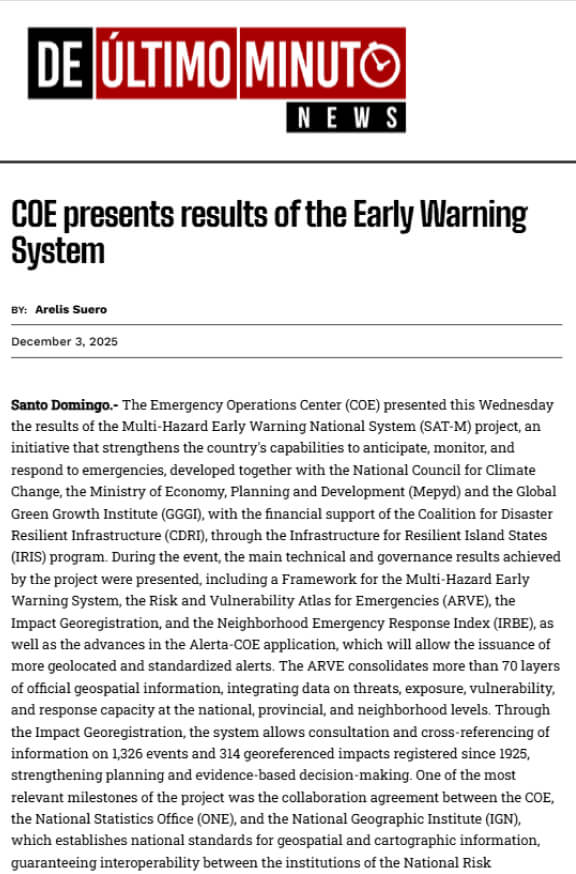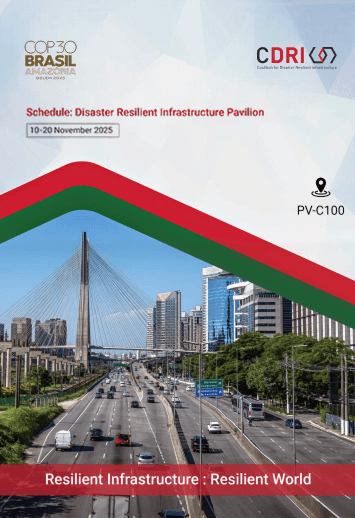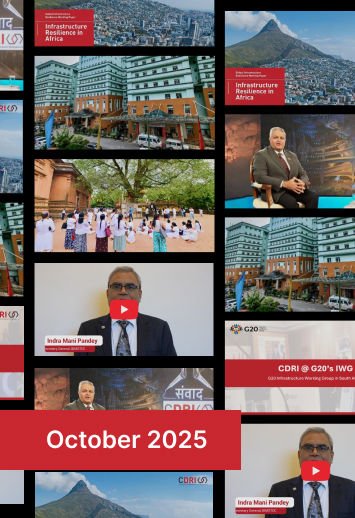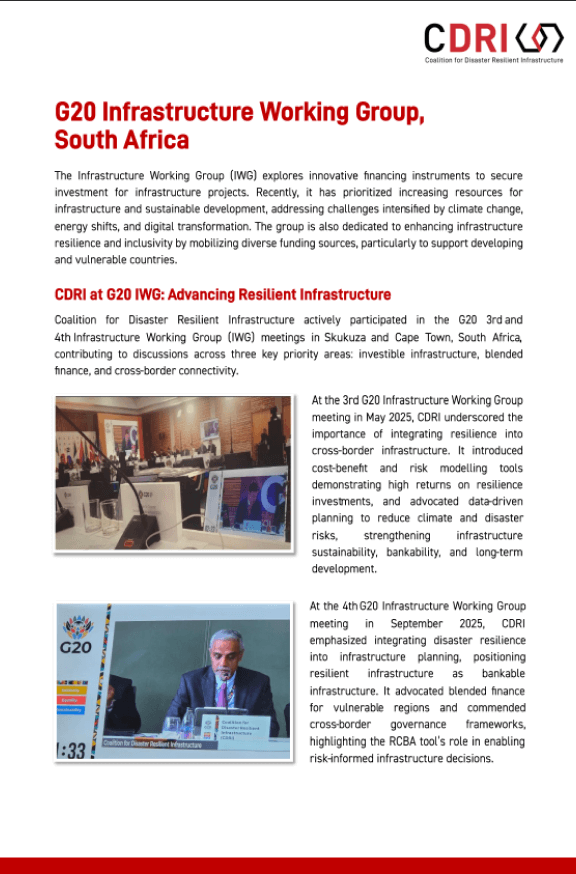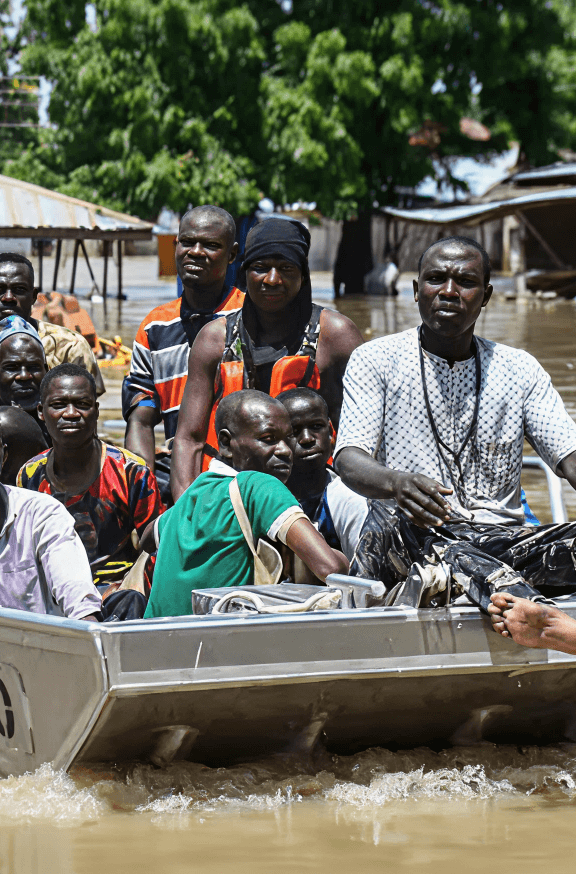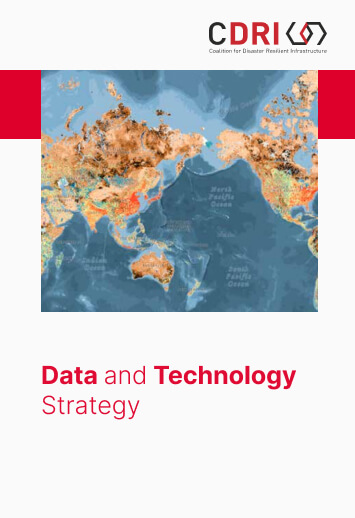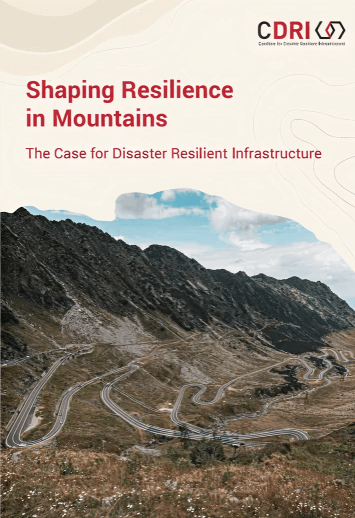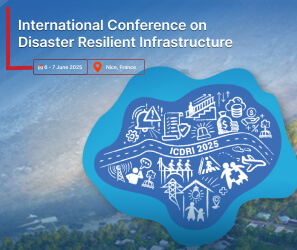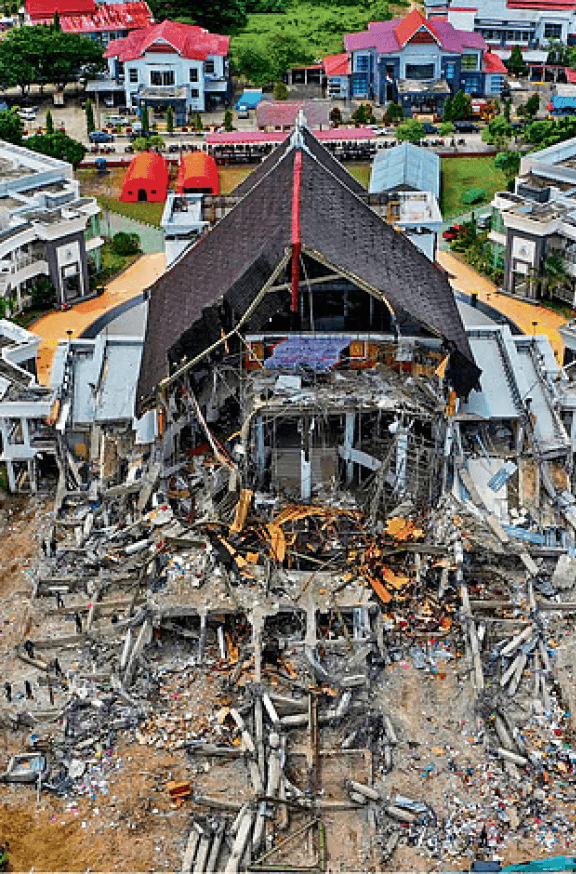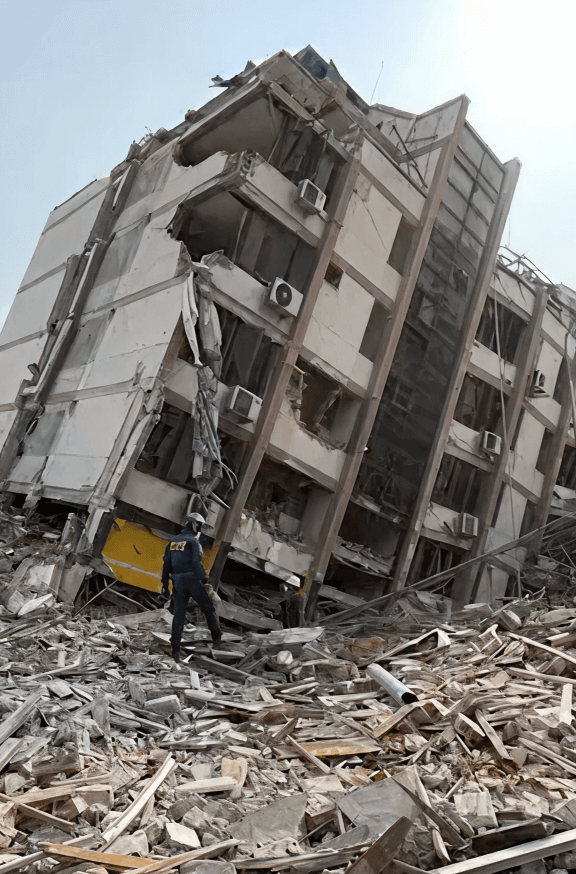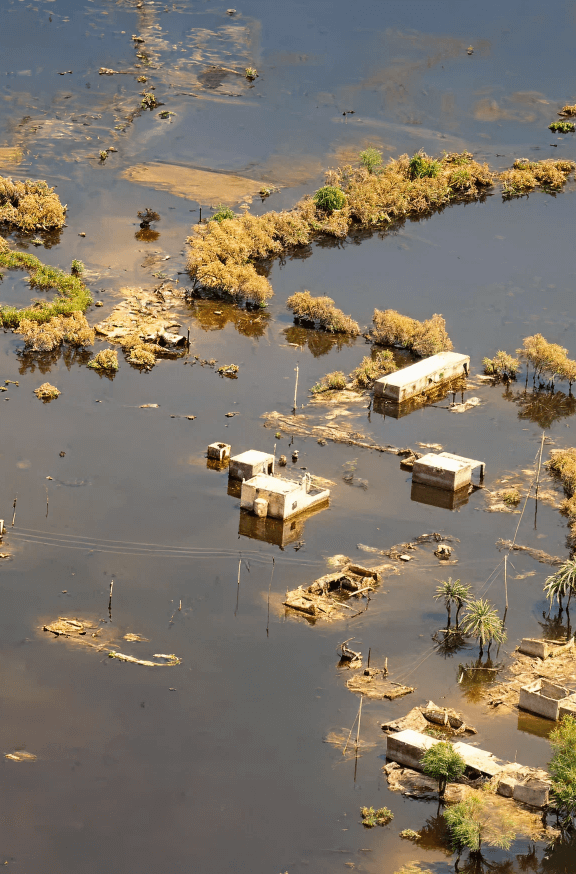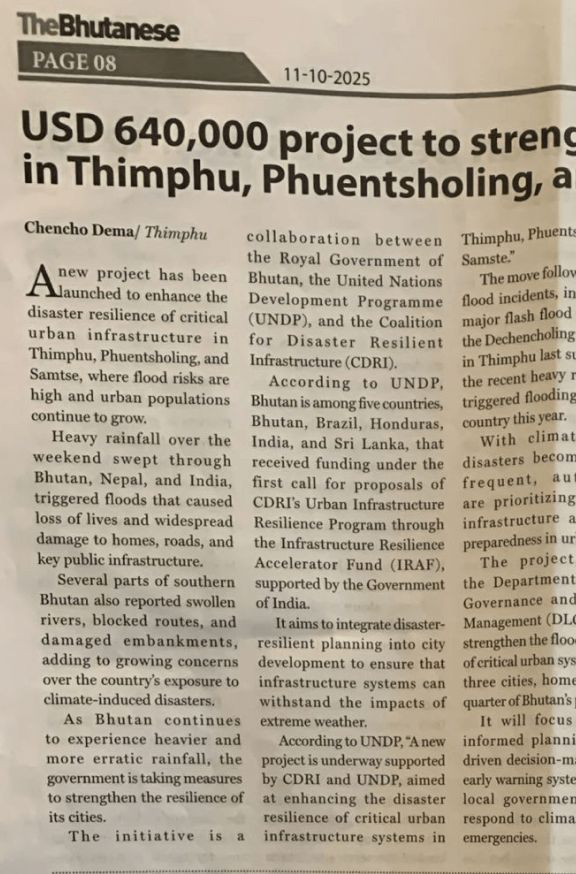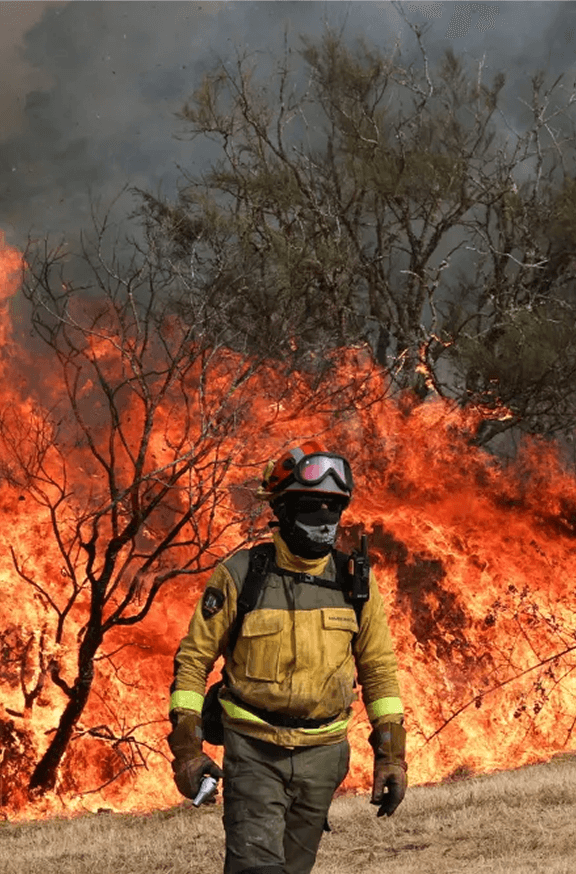In 2024
$173 billion
was lost to Storms
$33 billion
was lost to Floods
$18 billion
was lost to Earthquakes
Infrastructure resilience is a critical global challenge
14%
of global GDP growth is at risk
each year from infrastructure
losses to climate change and disasters
Source: CDRI
80%
of this risk is concentrated in the
critical power, transport, and
telecommunications sectors
Source: CDRI
Disaster resilient infrastructure absorbs, responds, and recovers swiftly from disasters; and returns a resilience dividend including:
- $4 return for each $1 invested
- Reduced loss and damage
- Limited service disruption
In order to make our infrastructure resilient in the face of disasters, India is launching a Coalition for Disaster Resilient Infrastructure. I invite all member states to join this Coalition.”
Prime Minister of India, Narendra Modi, 2019

CDRI: A Global Coalition

CDRI is dedicated to enhancing the resilience of infrastructure systems to climate and disaster risks. It includes national governments, international organizations, and the private sector. Members benefit from access to global expertise, funding, technical support, research opportunities, innovative solutions, and international best practices.
64 Members
183 Projects
$21.84mn Funding Disbursed

What we do: 16 Initiatives

Delivering
solutions for
DRI

Enabling
resilient
infrastructure

Where we work: 183 Projects
Loading . . .

Resources
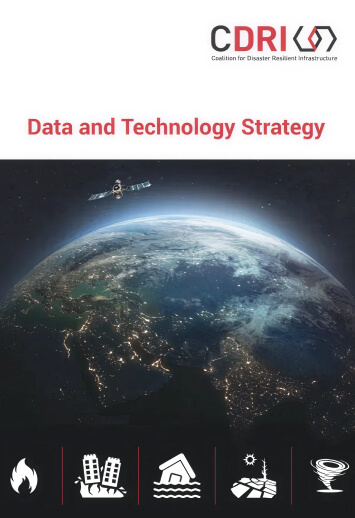
Data and Technology Strategy
CDRI’s data and technology strategy outlines a plan to strengthen member countries’ capacity to collect, access, and use high-quality geospatial and risk data, alongside advanced technologies such as AI/ML, IoT, remote sensing, and Earth observation.
Least Developed Countries (LDCs) and Small Island Developing States (SIDS) face the greatest challenges, including limited human resource capacity, inadequate hazard and infrastructure data, poor data governance, and high costs of technology.
The strategy aims to facilitate timely access to risk data, provide technical assistance and training, and build CDRI’s own technical resources. Expected outcomes include enhanced data generation and analysis, adoption of risk-informed policies, and improved resilience assessments. Organized around four themes and three output categories, the Strategy supports CDRI’s mission and priorities.
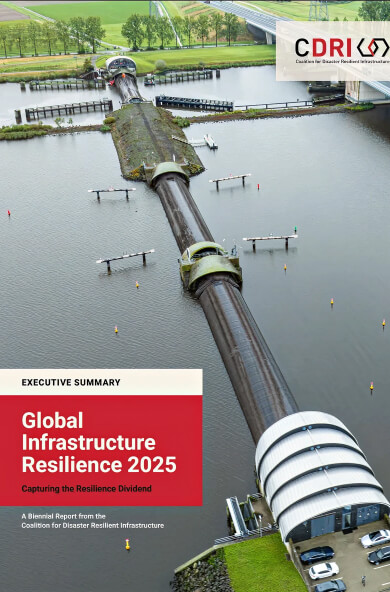
GIR 2025 Executive Summary
This is the Executive Summary of the Global Infrastructure Resilience Report 2025.
GIR 2025 report emphasizes the urgent need to incorporate resilience into infrastructure planning and investment. It shows that economic losses from service disruptions after disasters are, on average, 7.4 times higher than direct infrastructure damage.
The report emphasizes the importance of risk assessments, faster reconstruction, and governance reforms to reduce these losses. It advocates for localized risk modelling, institutional readiness, and innovative financing, including insurance and risk pooling. Businesses must also build end-to-end resilience across supply chains.
With over 75 case studies, GIR 2025 provides actionable insights across key pillars, including technology, finance, governance, and nature-based solutions. It calls for global cooperation to ensure infrastructure systems can withstand, adapt to, and recover from disasters, turning resilience into a driver of sustainable, inclusive growth.
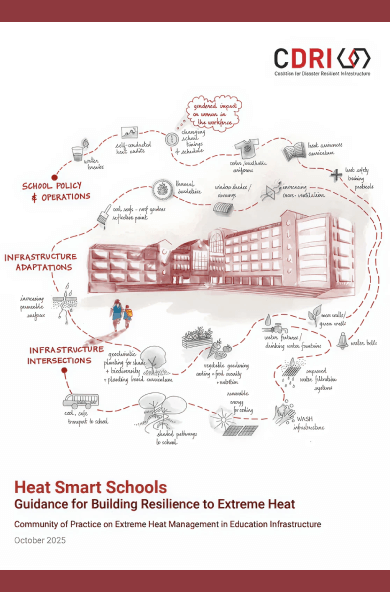
Heat Smart Schools
Guidance for Building Resilience to Extreme Heat
Community of Practice on Extreme Heat Management in Education Infrastructure
Heat Smart Schools is a guidance framework by CDRI to help schools adapt to rising extreme heat risks. With over two billion children projected to face frequent heatwaves by 2050, the document emphasizes that heat threatens health, learning, and equity, especially in vulnerable communities.
It outlines seven actionable steps: establish inclusive governance, use science and forecasts, implement structural and nature-based cooling measures, integrate heat literacy into education, address underlying risks like water and nutrition, mobilize financing, and prepare for future heat events through drills and recovery planning.
Recommendations span structural retrofits, passive cooling, shaded spaces, hydration systems, and community engagement. The guidance promotes a whole-of-society approach, linking schools with municipal, health, and disaster systems to ensure resilience and safeguard children’s right to learn in a warming world.

Action Agenda
Integrating Disaster Resilient Infrastructure in National Adaptation Strategies
The Action Agenda emphasizes the integration of Disaster Resilient Infrastructure (DRI) into national adaptation strategies as a critical response to escalating climate risks.
With 75% of global infrastructure yet to be built, mostly in the Global South, embedding resilience now is vital to avoid trillions in future losses. Climate-induced disasters already cause $700 billion annually, disproportionately impacting vulnerable economies. DRI adds 5–15% to upfront costs but yields 7–12x returns over asset lifecycles.
The agenda calls for systemic reforms: multi-hazard risk assessments, resilient design standards, governance coordination, innovative financing, and capacity building. It outlines ten action areas, including political leadership, critical asset protection, equity, and regional cooperation. COP30 is framed as a pivotal moment to shift from policy intent to operational integration, making resilience the backbone of adaptation and sustainable development.
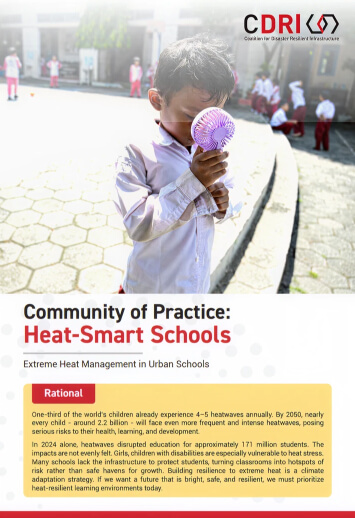
Community of Practice on Extreme Heat in Urban Educational Infrastructure: Heat Smart Schools
Extreme heat is increasingly disrupting education, affecting over 171 million students in 2024 alone. By 2050, nearly all children will face frequent heatwaves, with girls and children with disabilities being especially vulnerable. Many schools lack the infrastructure to protect students, making classrooms unsafe.
This Community of Practice aims to catalyze global dialogue, share best practices, and develop evidence-based guidance for heat-resilient schools. Key themes include heat-related inequities, health protocols, school design, and community roles. The CoP involves over 150 experts and 71 organizations, producing resources for policymakers and school administrators.
Recommendations include governance frameworks, scientific forecasting, child education, addressing root risks, infrastructure adaptation, financial strategies, and future preparedness. Building heat-resilient schools is essential for safeguarding children’s health, learning, and equity in a warming world.

A Roadmap for Resilient Health Infrastructure
Lessons from CDRI-WHO collaborative project in Sikkim (India)
This summary document captures CDRI–WHO project in Sikkim, which aimed to strengthen health infrastructure resilience against disasters and climate risks. Sikkim, prone to earthquakes, floods, and GLOFs, faced vulnerabilities across 178 health facilities.
The project developed a comprehensive Resilient Health Infrastructure (RHI) Framework covering hospital operations, building safety, critical services, community systems, and governance. Key actions included capacity-building workshops, mock drills, and the creation of a Hospital Disaster Risk Management & Resilience Plan (HDRM&RP). Post-2023 GLOF, the framework guided effective response and recovery. The initiative emphasized systemic integration, policy reforms, and multi-sectoral coordination. Sikkim received national recognition for fire safety and aims to scale resilience measures.
CDRI plans to expand the RHI model globally, supported by a Community of Practice and technical partnerships.

GIR Working Paper: SIDS
The 2025 GIR SIDS Working Paper by CDRI analyzes infrastructure resilience in Small Island Developing States (SIDS) using the Global Infrastructure Risk Model and Resilience Index (GIRI). It highlights SIDS’ vulnerability to climate and geological hazards due to limited land, economic size, and coastal infrastructure concentration.
The paper estimates high Average Annual Losses (AAL), especially in the energy and telecommunications sectors, and projects increased risks from climate change. It proposes a resilience framework based on three capacities, absorb, respond, and recover, and emphasizes financial instruments, institutional reforms, and user resilience.
The Call to Action outlines ten steps to enhance resilience, including data hubs, localized standards, and finance reforms. CDRI’s IRIS program supports 24 projects across 25 SIDS, promoting resilient infrastructure through technical, financial, and policy assistance.
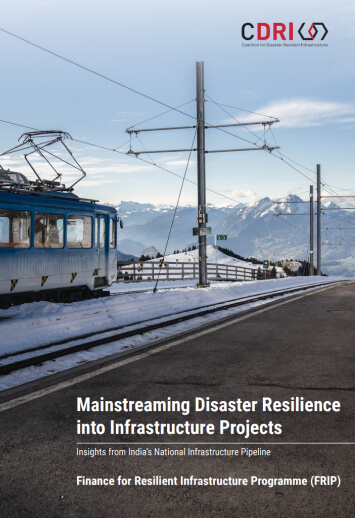
Mainstreaming Disaster Resilience into Infrastructure Projects: Insights from India’s National Infrastructure Pipeline
The document outlines efforts by CDRI to integrate climate and disaster resilience into India’s National Infrastructure Pipeline (NIP). It includes cost-benefit analyses (CBA) of five sectoral projects and reviews of standard agreements in roads, power, and rail sectors to identify resilience gaps.
A key tool developed is the Resilience CBA dashboard, which compares lifecycle costs with and without resilience measures. The document also proposes revisions to procurement and contractual documents to include risk-sharing and force majeure clauses.
A comprehensive disaster resilience toolkit is introduced, offering design options, evaluation guidance, and proposal preparation support for ministries and bidders. The goal is to reduce financial losses, improve infrastructure resilience, and promote disaster-informed investment decisions across India’s infrastructure ecosystem.

GIR Working Paper: Africa
The GIR 2025 Africa Working Paper by CDRI presents the first comprehensive assessment of infrastructure risks in Africa using the Global Infrastructure Risk Model and Resilience Index (GIRI).
The paper estimates Africa’s average annual loss (AAL) from disasters at $12.7 billion, with floods and earthquakes as primary hazards. Eastern Africa bears the highest AAL, while smaller nations face proportionally greater economic impacts. Climate change is projected to increase losses by 27%.
It highlights sector-specific vulnerabilities in transport, energy, and urban infrastructure, and emphasizes the need for resilient design, maintenance, and early warning systems. It advocates for financial instruments and institutional reforms to enhance infrastructure resilience.
African governments are leading adaptation efforts, but global support remains crucial. The report calls for coordinated action ahead of the 2025 G20 Summit and COP30.
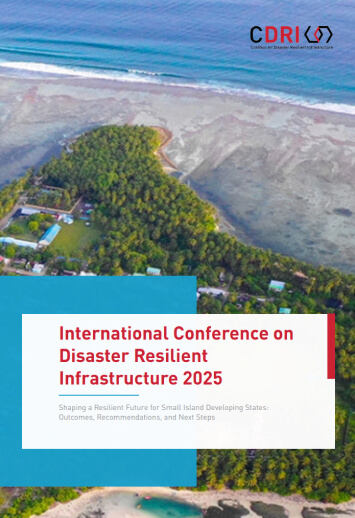
ICDRI 2025: Shaping a Resilient Future for Small Island Developing States: Outcomes, Recommendations, and Next Steps
The International Conference on Disaster Resilient Infrastructure (ICDRI) 2025, held in Nice, France, focused on enhancing infrastructure resilience in Small Island Developing States (SIDS). With 220 delegates from 52 countries, the event emphasized leadership, finance, and technology.
Key outcomes included a Call to Action with ten concrete steps, such as launching the SIDS Global Data Hub 2.0, developing modular design codes, and embedding resilience units in finance ministries. Discussions highlighted the need for adaptive governance, inclusive early warning systems, and innovative financing mechanisms. CDRI is committed to advancing these goals through partnerships, technical assistance, and global advocacy.
The conference aligned with global frameworks like the Sendai Framework and COP30, aiming to shift from reactive aid to anticipatory resilience and ensure sustainable development for vulnerable island nations.
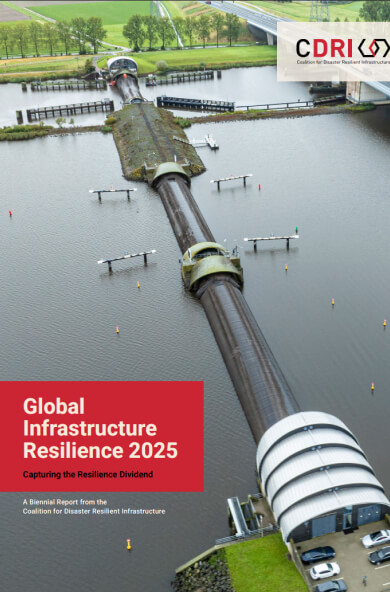
Global Infrastructure Resilience Report 2025
The Global Infrastructure Resilience Report by CDRI emphasizes making infrastructure resilience a core economic strategy.
Global disaster-related losses exceed $732 billion annually, with indirect costs averaging 7.4 times direct damages. Using GIRI model and Green Economy Model (GEM), it shows that faster reconstruction, within 10 years, can halve GDP losses.
Key priorities include localized risk assessments, layered financing (bonds, insurance, contingency funds), and governance reforms to overcome regulatory gaps. Technologies like AI, drones, and digital twins, along with nature-based solutions, offer cost-effective resilience. Businesses and governments must embed resilience across planning, operations, and recovery. Africa and Small Island Developing States face disproportionate risks, while renewable energy and irrigation sectors need urgent adaptation.
The report provides actionable frameworks, financing pathways, and case studies to capture the resilience dividend globally.
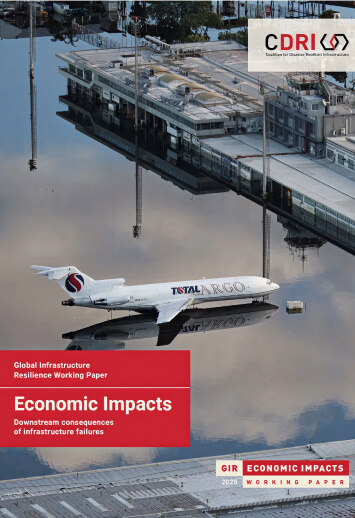
Global Infrastructure Resilience 2025 Working Paper: Economic Impacts Downstream consequences of infrastructure failures
This GIR 2025 Working Paper highlights how disasters affect economies far beyond the direct damage to assets. When infrastructure services such as water, electricity, and transport fail for prolonged periods, the ripple effects disrupt businesses, livelihoods, and essential public services.
Using the Global Infrastructure Risk Model and Resilience Index (GIRI) in conjunction with the Green Economy Model (GEM), the study reveals that indirect costs are, on average, 7.4 times higher than direct damages, reaching up to 16 times higher in some countries. Between 2025 and 2050, infrastructure failures could reduce GDP growth by 5.2% annually, with losses rising to 7.4% by 2050, and even higher in vulnerable nations like Bangladesh and the Philippines.
Crucially, rapid reconstruction reduces impacts significantly – a 10-year recovery lowers GDP losses to 3%, while a 4year recovery cuts them to 2.27%. Investments in resilience and preparedness deliver substantial economic dividends.
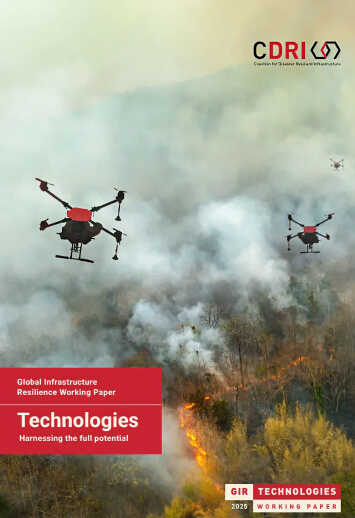
GIR 2025 Working Paper : Technologies
This GIR 2025 Working Paper explores how technology can transform infrastructure resilience across the disaster cycle.
It identifies three core functions: enhancing the data value chain, improving connectivity and collaboration, and strengthening asset and network performance. Technologies such as AI, IoT, digital twins, 3D printing, and nature-based solutions offer cost-effective ways to anticipate risks, maintain service continuity, and accelerate recovery.
Case studies highlight practical applications from drone-based inspections to blockchain-enabled cash transfers. While benefits include reduced losses and improved sustainability, adoption faces challenges – governance gaps, financing constraints, skills shortages, and cybersecurity risks. The paper proposes a readiness checklist and enabling environment framework to guide governments and operators in moving from pilots to scalable, inclusive, and future-ready technology adoption for resilient infrastructure.
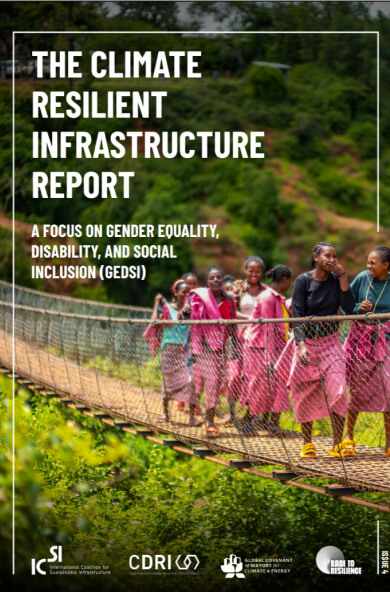
The Climate Resilient Infrastructure Report: A Focus on Gender Equality, Disability and Social Inclusion
This report, by International Coalition for Sustainable Infrastructure (ICSI), Coalition for Disaster Resilient Infrastructure (CDRI), and The Global Covenant of Mayors for Climate and Energy (GCoM), emphasizes embedding inclusivity across the infrastructure lifecycle to address climate risks and social inequities. It aligns with global frameworks like the SDGs, Paris Agreement, and Sendai Framework, advocating for policies, design standards, and operations that prioritize vulnerable groups.
The report showcases over 40 case studies worldwide, including hospital upgrades in Kiribati, inclusive school reconstruction in Nepal, and trail bridges in Rwanda, demonstrating how GEDSI integration improves resilience, access, and equity.
Key strategies include participatory planning, universal design, gender-responsive budgeting, and accessibility audits. By mainstreaming GEDSI, infrastructure can reduce vulnerability, accelerate recovery, and foster sustainable development. These initiatives have already enhanced resilience for over 36 million people globally, proving that inclusive, climate-smart infrastructure is essential for equitable adaptation and long-term resilience.

Shaping Resilience in Mountains
The Case for Disaster Resilient Infrastructure
Mountains, covering 27% of Earth and home to 1.2 billion people, are vital for biodiversity and water security but face severe climate-induced hazards like floods, landslides, and glacial lake outburst floods. Their fragile ecosystems, remoteness, and limited infrastructure amplify vulnerability, making disaster resilient infrastructure (DRI) essential for survival and connectivity.
The report by CDRI emphasizes integrating technological innovations, ecosystem-based adaptation, and Indigenous knowledge to design resilient systems. It highlights cascading risks, governance gaps, and financing challenges, calling for multi-hazard risk-informed planning, inclusive policies, and sustainable maintenance.
Strategic pathways include early warning systems, gender-responsive approaches, and diversified financing through public-private partnerships and climate funds. Case studies worldwide demonstrate scalable solutions combining engineering and nature-based strategies. Collective action is urgent to safeguard lives, livelihoods, and ecosystems in mountain regions amid accelerating climate change.
Collaboration
- Global Mountain Safeguard Research (GLOMOS) programme
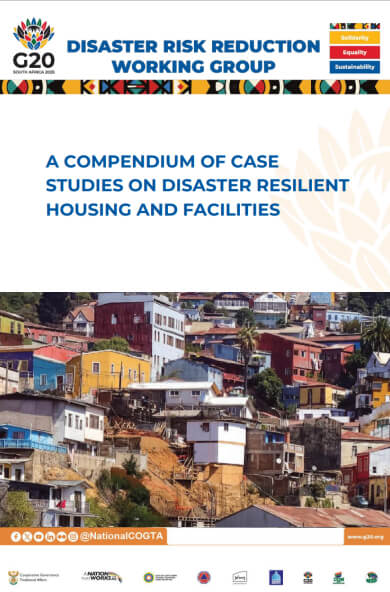
A Compendium of Case Studies on Disaster Resilient Housing and Facilities
This compendium showcases 26 global case studies on disaster resilient housing and infrastructure, emphasizing climate adaptation, community-led recovery, and inclusive development.
It highlights scalable models like India’s PMAY-G, Indonesia’s RISHA prefab homes, and Japan’s seismic retrofitting policy. Owner-driven reconstruction, vernacular architecture, and gender-inclusive approaches are central themes. Countries such as Afghanistan, Mozambique, and Colombia demonstrate effective post-disaster housing solutions through the use of local materials, training, and policy reform. Innovations include Singapore’s environmental modelling, UK’s integrated flood resilience, and UAE’s passive cooling via Barjeel towers.
The compendium aligns with the Sendai Framework and G20 DRRWG priorities, offering actionable insights for policymakers, engineers, and NGOs to reduce vulnerability, enhance resilience, and promote sustainable housing solutions globally.
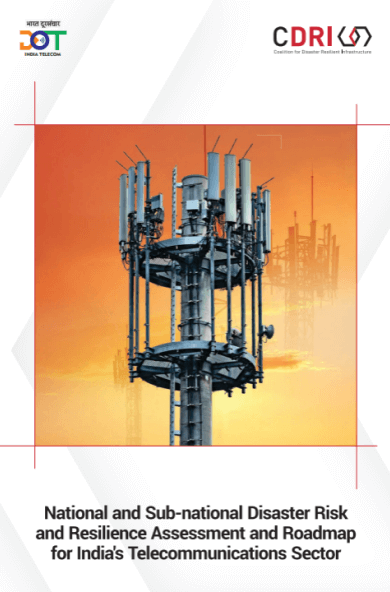
National and Sub-national Disaster Risk and Resilience Assessment and Roadmap for India’s Telecommunications Sector
India’s telecom sector, contributing ~15% to global GDP, faces rising disaster risks due to its vast infrastructure and geographic vulnerability.
The CDRI-led study assesses multi-hazard resilience across mountains, plains, and coasts, using GIS mapping and stakeholder consultations. The Disaster Risk and Resilience Assessment Framework (DRRAF) integrates global best practices to guide infrastructure upgrades, policy reforms, and emergency planning.
Key recommendations include intra-circle roaming awareness, HAPS deployment, SATCOM interoperability, and parametric insurance. India’s telecom landscape includes 1.2B subscribers, 814K towers, and 950M internet users. Vulnerabilities span power logistics, network congestion, and submarine cable delays. State-level initiatives and SOPs support emergency communication.
A national roadmap proposes structural upgrades, community integration, and resilience indices to ensure continuity and rapid recovery during disasters.
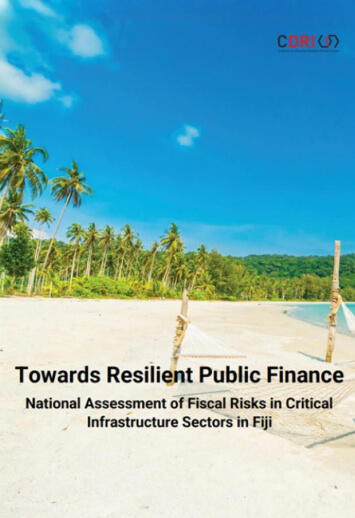
Towards Resilient Public Finance in Fiji
Towards Resilient Public Finance: National Assessment of Fiscal Risks in Critical Infrastructure Sectors in Fiji
Fiji faces mounting fiscal risks from frequent climate and geological disasters, notably tropical cyclones and floods. These events severely impact critical infrastructure, especially power and transport, leading to economic shocks, reduced revenues, and increased public debt.
This report assesses historical and future disaster-related losses using economic and catastrophe modelling, revealing significant funding gaps. Current financing relies heavily on budget reallocations and international aid.
Recommendations include upgrading infrastructure standards, institutionalizing pre-arranged disaster funds, expanding risk-layered financing, integrating disaster-linked liabilities into debt strategies, and enhancing sector-specific insurance.
Strengthening data systems and adopting global best practices are vital for fiscal resilience. Without proactive measures, Fiji risks unsustainable recovery costs and delayed development. The report offers a roadmap for resilient public finance and disaster preparedness.

A Compendium of Good Practices on Disaster Resilient Infrastructure (DRI)
This compendium, compiled by CDRI and G20 partners, showcases 52 global case studies on disaster resilient infrastructure. It spans sector-specific interventions, post-disaster reconstruction, financing mechanisms, nature-based solutions, risk assessments, and governance frameworks.
Highlights include India’s early warning systems, Nepal’s earthquake-resilient schools, Australia’s Betterment Fund, and Brazil’s water infrastructure projects. The document emphasizes inclusive, community-centered approaches, innovative financing like parametric insurance, and the integration of resilience into national policies and building codes.
It also features tools like GIRI and PCRAM for risk modelling. The compendium promotes knowledge exchange, aiming to support Least Developed Countries (LDCs), Landlocked Developing Countries (LLDCs), and Small Island Developing States (SIDS) in building sustainable, resilient infrastructure systems.

Physical Climate Risk Assessment Playbook for the Financial Sector
The “Physical Climate Risk Assessment for the Financial Sector” playbook, developed by CDRI and supported by The Rockefeller Foundation, guides financial institutions (FIs) in low- and middle-income countries (LMICs) to assess and manage physical climate risks.
It outlines a structured approach—awareness, assessment, and action—emphasizing the hazard-exposure-vulnerability (HEV) framework and climate value-at-risk (VaR) modelling. The playbook promotes integrating climate risk into governance, strategy, and credit processes, while highlighting opportunities in green finance. It addresses challenges like data gaps, lack of standardization, and limited macro-level guidance.
Tools like the Global Infrastructure Risk Model and Resilience Index (GIRI) support localized risk analysis. The document calls for collaboration among regulators, policymakers, and FIs to institutionalize climate risk assessments and unlock financing for climate-resilient infrastructure, ensuring long-term economic and environmental sustainability in LMICs.

Global Methodology for Infrastructure Resilience Review
The Global Methodology for Infrastructure Resilience Review provides a structured, five-step approach to help countries assess and enhance the resilience of their infrastructure systems.
Developed by UNDRR and CDRI, it begins with mapping institutional governance and identifying key stakeholders across sectors. It then reviews existing policies and regulations to evaluate alignment with disaster risk reduction (DRR) and climate change adaptation (CCA). The third step involves stress-testing infrastructure systems against multiple hazards to detect vulnerabilities and interdependencies. Step four assesses current practices using the Principles for Resilient Infrastructure through stakeholder workshops and scorecards. Finally, the methodology guides the development of an implementation plan and final report, consolidating findings and prioritizing actions.
Emphasizing cross-sectoral coordination, data-driven analysis, and stakeholder engagement, the methodology supports countries in mainstreaming DRR into infrastructure planning, design, and governance. It aims to foster resilient, sustainable infrastructure systems that can withstand and adapt to evolving risks.

Global Infrastructure Resilience: Capturing the Resilience Dividend
This report presents a compelling case for investing in resilient infrastructure. It introduces the Global Infrastructure Risk Model and Resilience Index (GIRI), the first global, probabilistic tool estimating financial risk across infrastructure sectors. The report highlights that 60% of the infrastructure needed by 2050 is yet to be built, and without resilience, $732 – $845 billion in annual losses are expected. It emphasizes the resilience dividend—benefits like avoided losses, reliable services, and environmental gains.
Key recommendations include integrating Nature-based Infrastructure Solutions (NbIS), improving governance, mobilizing private capital, and adopting national resilience strategies. The report calls for systemic change, especially in LMICs, where infrastructure deficits and climate risks are greatest. It offers a roadmap to align infrastructure investment with sustainable development, climate goals, and fiscal resilience.






